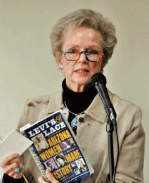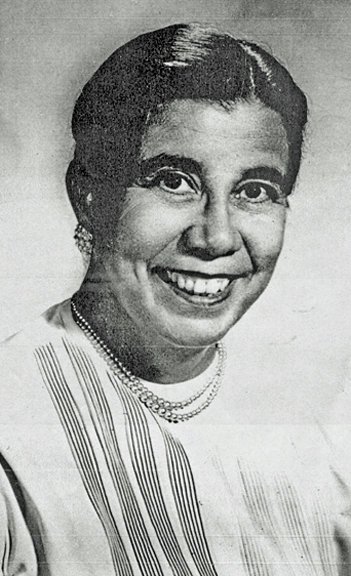Road Scholars Speakers Bureau Programs
Jan has been a member Arizona Humanities Road Scholars Speakers Bureau program for several years, speaking throughout the state to libraries, historical societies, and a variety of civic and social organizations.
The following presentation can be booked through the Arizona Humanities website: http://www.azhumanities.org/programs/azspeaks
Maria Urquides: Mother of Bilingual Education
Maria Urquides’ Hispanic background made her the ideal teacher for Arizona’s bilingual schools although she readily admitted she might go to Hell for being ordered to punish students for speaking Spanish in the classroom. She stepped on more than a few administrative toes to attain her goal of promoting bilingual/bicultural education to children of all backgrounds. Maria was a driving force in encouraging passage of the 1968 Bilingual Education Act providing federal funds for students with limited English-speaking abilities. While the Act encouraged instruction in English, it also promoted multicultural awareness. Five U.S. Presidents appointed Maria to national panels and conferences for children and education. She was a woman who made a definitive difference in the education of children of all races and ethnicities and is credited with being the single most effective force behind the implementation of bilingual education across the country.
Other Programs by Jan Cleere
Military Wives in Arizona Territory
When the U.S. Army ordered troops into Arizona Territory in the nineteenth century to protect and defend newly established settlements, military men often brought their wives and families, particularly officers who might be stationed in the west for years. Most of the women were from refined, eastern-bred families with little knowledge of the territory. Their letters, diaries, and journals from their years on army posts reveal untold hardships and challenges. They learned to cope with the sparseness, the heat, sickness, and danger, including wildlife they never imagined. These women were bold, brave, and compassionate. They became an integral part of military posts that peppered the West and played an important role in civilizing the untamed frontier. Learn about these extraordinary women who ventured into the early wild, wild West.
Legacies of the Past:
Arizona Women Who Made History
From artists and healers, teachers and entrepreneurs, women who plowed the land, and those who were instrumental in establishing laws for the new territory of Arizona, many early Arizona women became known for their fortitude in the face of adversity, their confrontation of extraordinary and sometimes dangerous situations, their adventuresome spirits, and their dedication to improving the lives of others. Some of these women gained a degree of celebrity across the state, within their communities, and throughout their tribal regions. Others remained relatively unknown. Author, historian, and lecturer Jan has put together a celebration of women who helped shape Arizona history. Taken from her book, Levi’s & Lace: Arizona Women Who Made History, a compilation of over thirty women from Native American, African American, Hispanic, and Anglo descents, Jan’s presentation recalls the lives of amazing women who had an impact on the territory and the state.
The Woman Who Shot Cowboys:
Rodeo Photographer Louise L. Serpa
Anyone who has ever stared down an angry bull coming full throttle across an arena will understand why rodeo photographer Louise Serpa often uttered the adage “Never Don’t Pay Attention." Born into New York society, Louise ended up out west with her nose buried in the dirt and her eye glued to a camera, becoming the first woman to venture inside the arena & shoot some of the most amazing photographs of rodeo action. The dust & dirt of the rodeo arena became Louise’s lifeblood for almost 50 years. She is also credited with becoming the first woman to photograph England’s Grand National Steeplechase, the Dublin Horse Show, and the Sydney (Australia) Royal Easter Show. Her story shows the courage and resolute of a woman determined to decide her own fate at a time when women were expected to marry, raise a family and know their place in society.
Pens and Paintbrushes: Legacies of Early Arizona Women in the Arts
This PowerPoint program explores the lives of 5 artists whose talents personify the beauty of the early western frontier. Hopi potter Nampeyo shaped clay vessels with an intricacy seldom duplicated today. Writer Sharlot Hall described images of Arizona’s past and preserved our history. Author Martha Summerhayes wrote of her adventures following her husband from one Arizona army post to another. Kate Cory’s abundant portfolio of paintings & photos illustrates an intense cultural sensitivity to Hopi rituals & ceremonies. Mary Colter designed edifices across the southwest, particularly at the Grand Canyon. Folk singer Katie Lee still expresses herself through songs & writings
This Land is Our Land:
Early Women
on the Arizona Frontier
Meet five early Arizona women who endured troubles and hardships during the territory’s early days, bringing a unique perspective to this raw land. Apache warrior Lozen fought to hold onto land once freely roamed by her people. Larcena Pennington crawled down the Santa Rita Mountains after surviving captivity by the Apaches. Mary Aguirre found traveling the 1300-mile Santa Fe Trail an exhilarating adventure. Ada Bass played an integral role in one of the first tourist businesses at the Grand Canyon. Mormon Emma Lee French survived untold hardships raising a family at the site of what is now Lees Ferry.
Oh Heavens!
Saviors and Saints
on the Arizona Frontier
Women of many faiths cared for the bodies and souls of Arizona’s early inhabitants. Meet five who influenced the history of the territory. Theresa Ferrin’s holistic practices and comprehensive understanding of healing herbs earned her the title “Angel of Tucson.” Florence Yount is recognized as Prescott’s first woman physician. Teresita Urrea was sometimes considered a saint for her hands-on healing powers. St. Katharine Drexel invested much of her vast fortune to educate Navajo children. And the Sisters of St. Joseph of Carondelet trudged across the blazing desert enduring untold hardships, even marriage proposals, before arriving safely in Tucson.
Business Not As Usual: Arizona's Early Women Entrepreneurs
Women have always been in business of one type or another. Meet five of Arizona’s early female entrepreneurs. Prospector Nellie Cashman established restaurants in towns across the territory. Sarah Bowman, a shrewd business-woman with a tarnished reputation, operated dining establishments for the soldiers of Fort Yuma. Trading post owner Louisa Wetherill replicated intricate Navajo sand paintings, preserved Navajo stories, and maintained vast collections of Native herbs and plants. African American Elizabeth Smith successfully built and ran Wickenburg’s Vernetta Hotel. The first female newswoman in the territory, Angela Hammer constantly battled unscrupulous men who believed no woman should run a newspaper.
Teacher, Teacher:
Early Women Educators
of Arizona
Playing an integral role in early Arizona communities, teachers attained goals far beyond what was expected in the classroom. Mary Elizabeth Post taught school in an abandoned saloon as well as an old jailhouse. Hopi teacher Polingaysi Qöyawayma (Elizabeth White) educated Hopi and Navajo students, bridging the gap between Anglo and Native cultures. Eulalia “Sister” Bourne introduced newsletters to teach English to her Spanish-speaking children. Maria Urquides’ Hispanic background made her the ideal teacher for Tucson’s bilingual schools. Earning less than her white counterparts, African American Rebecca Huey Dallis had an enormous influence on the Black children of Casa Grande.
Desperado Trails:
Outlaws on the Arizona Frontier
Hang on to your hats as you ride the trails beside some of Arizona’s most wicked renegades during a time when massacres, mayhem and mischief ran rampant throughout Arizona Territory. Learn the sordid details of desperadoes such as cattle/horse rustler and murderer Augustine Chacon who claimed he killed over fifty men, ladies-man Buckskin Frank Leslie who had a deadly aim and an impatient trigger finger, lawman-turned-outlaw Burt Alvord, and murderer Charles P. Stanton. And watch out for the ladies! Met petite horse and cattle thief Cecil Creswell and everyone’s darling, stagecoach robber Pearl Hart.
They Knew No Boundaries:
Pioneering Girls of Arizona
From the mid-1800s to the mid-1900s, adolescent girls in Arizona were expected to care for younger children, cook and clean, feed the poultry and pigs, milk the cows, administer to sick animals, and tend gardens. They also helped mend fences, round up wandering herds, and repair dried-up water holes. Yet, even as they toiled, they strained against the confines of housework and home chores. Some struggled to adapt in this ever-changing landscape while others tossed off their restrictive sunbonnets and rode across the countryside unrestrained. These stories of young girls who, before the age of eighteen, broke through social barriers, coped with the rawness and isolation of the early West, the lack of education, and sometimes the disparity between the races, bring to light the harshness of living in the territory during the early years of settlement and civilization.












